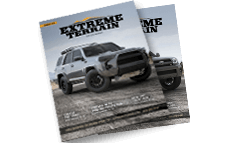

Jeep Caster Angle Settings Explained
Jeep caster angle (also "castor" angle) is one of those things you'll come across a lot. Primarily because most mods that are popular on a Jeep involve the suspension. No matter what you do, chances are, there's going to be a front end, or 4-way alignment involved at the end. So today we are talking about Caster.
What is Caster Angle
The term "caster" refers to the to the steering axis of the wheel/tire. You might think that by looking at a tire with your eye that it's straight up and down with the suspension, or more precise, with the spindle mount. That's only somewhat true. The easiest way to illustrate it simply is by using a common caster wheel. You know, those wheels on shopping carts that sometimes have a mind of their own and drive you crazy in the aisles. In the image above, you'll notice the center of the wheel, it's hub let's say, is vertically just behind the threaded part at the top. Since the wheel is behind the stud mount, it tends to follow the stud, automatically. Meaning, when pushed in a straight line, the wheel will automatically adjust itself and straighten out, in the direction you are steering the cart. If you turn left or right, the wheel turns with you. All because of it's "caster" position. If the stud was mounted directly in line with the hub, you could still push the cart, and the wheel would eventually turn, but just a few degrees of caster makes all the difference.
How does Caster apply to a Jeep?
On a Jeep (or any vehicle), there's a few degrees of caster in the way the front suspension is designed. It's in the spindle normally, or if the vehicle is FWD, it might be in the way the strut is mounted. Every vehicle is a little different. On a Jeep, it's where the ball joints line up on the end of the axle. Meaning, if you take the tire off and look head-on at the ball joints from the side, you'll see they're not exactly vertical. There are several reasons this feature is built into a vehicle you drive. It makes the front wheels want to go in a straight line automatically, just like on the grocery cart. That's why when you let go of your steering wheel, the vehicle normally continues in a straight forward manner. It also makes steering easier (just like on a cart). It only takes a few degrees to make it all work. The degrees, or the measurement of them, can be different for different vehicles. When you get your Jeep aligned at a repair shop, checking the caster is one of the measurements the mechanic (and the machine) records. They already know what the measurement should be, and compare that to what they find when they check. If needed, they can change the degrees of the caster angle. That's not always possible though, many vehicles have a fixed caster setting, and it can't be changed, except with a modification of some sort.
What Happens to Caster Angle if I lift My Jeep?
Sometimes you may want to change your caster angle from the factory settings. This is to keep the geometry of the suspension and possibly the driveshaft in the correct alignment. So the Jeep can be driven safely, and with less chance of breaking a part, or losing a driveshaft. For instance, you might use a Rough Country Front Control Arm Relocation Kit, Part RC-1106 to help improve a driveshaft angle. Many companies make Cam Bolts to help make an adjustment beyond what the stock suspension can do. Kits like Zone Offroad's Front Alignment Cam Bolts, Part ZON-J5311, or Pro Comp's Alignment Kit Cambolts, part 20-65227. Some companies make ball joint kits that allow you to adjust caster alignment, like the part SAI-44-2490-K. When to change your Caster settings depends on many variables, and the modifications you made to your suspension. Sometimes, maybe most of the time, no caster change is needed. Typically the company who makes a lift kit will tell you if you need to change the specs on the castor alignment. So there you go. Caster is basically just one of the measurements needed to keep your Jeep in alignment and working on down the road. Related Products Zone Offroad Front Alignment Cam Bolts $34.05 Price match guarantee Have you ever needed to adjust your caster due to a Jeep mod? Tell us about it!

